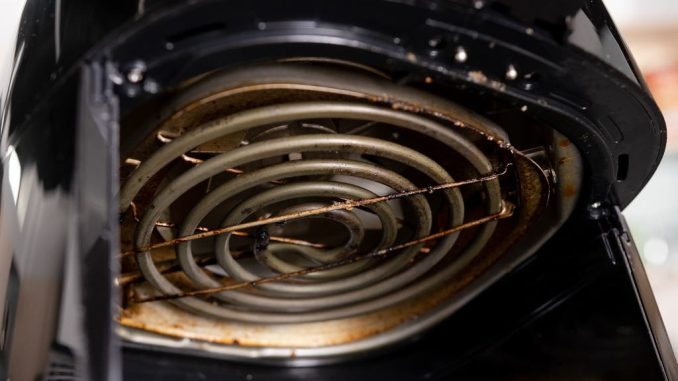
Table of Contents
- Introduction: Understanding the Importance of Cleaning Your Air Fryer
- Safety Precautions Before Cleaning
- Tools and Materials You’ll Need
- Step-by-Step Guide to Cleaning Your Air Fryer’s Heating Element
- 4.1 Unplug and Cool Down Your Air Fryer
- 4.2 Remove the Cooking Basket and Tray
- 4.3 Wipe the Interior Surfaces
- 4.4 Cleaning the Heating Element
- 4.5 Cleaning the Exterior Surfaces
- 4.6 Reassembling Your Air Fryer
- Tips to Maintain a Clean Air Fryer
- Conclusion
- FAQs
- FAQ 1: How often should I clean my air fryer?
- FAQ 2: Can I use abrasive cleaners to clean the heating element?
- FAQ 3: Is it safe to immerse the heating element in water?
- FAQ 4: What should I do if I notice a burning smell while using my air fryer?
- FAQ 5: Can I clean my air fryer in the dishwasher?
1. Introduction: Understanding the Importance of Cleaning Your Air Fryer
Air fryers have gained immense popularity due to their ability to cook crispy and delicious meals with little to no oil. However, to ensure optimal performance and longevity of your air fryer, regular cleaning is essential. Among the various components, the heating element at the top is crucial for even cooking and requires proper maintenance. In this article, we will guide you through the process of cleaning the inside of your air fryer, with specific emphasis on the heating element.
2. Safety Precautions Before Cleaning
Before you begin cleaning your air fryer, it is important to take some safety precautions:
- Ensure that your air fryer is unplugged and completely cooled down.
- Avoid using harsh chemicals or abrasive cleaners that may damage the heating element or other parts of the appliance.
- Read the manufacturer’s instructions for specific cleaning guidelines.
3. Tools and Materials You’ll Need
To clean the inside of your air fryer and its heating element, gather the following tools and materials:
- Soft microfiber cloth or sponge
- Mild dish soap
- Warm water
- Soft-bristle brush
- Toothbrush (optional)
- Dry cloth or paper towel
4. Step-by-Step Guide to Cleaning Your Air Fryer’s Heating Element
4.1 Unplug and Cool Down Your Air Fryer
Before you start cleaning, make sure your air fryer is unplugged and has cooled down completely. This step is crucial to ensure your safety and prevent any potential accidents.
4.2 Remove the Cooking Basket and Tray
Take out the cooking basket and tray from your air fryer. These components can be washed separately with warm water and mild dish soap. Set them aside to dry.
4.3 Wipe the Interior Surfaces
Using a soft microfiber cloth or sponge, wipe the interior surfaces of your air fryer. Remove any food residue or grease that may have accumulated. For stubborn stains, you can mix warm water with mild dish soap and gently scrub the affected areas.
4.4 Cleaning the Heating Element
The heating element is located at the top of your air fryer and is responsible for generating the heat necessary for cooking. Cleaning this component requires extra care:
- Dip a soft microfiber cloth or sponge into a mixture of warm water and mild dish soap.
- Gently wipe the heating element, being cautious not to apply excessive pressure or damage the delicate surface.
- If there are any stubborn stains or residue, you can use a soft-bristle brush or a toothbrush to carefully remove them.
- Once the heating element is clean, use a dry cloth or paper towel to wipe away any excess moisture.
4.5 Cleaning the Exterior Surfaces
Clean the exterior surfaces of your air fryer using a damp cloth and mild dish soap. Be sure to remove any fingerprints, stains, or grease from the control panel, handle, and other accessible areas. Dry the exterior with a clean cloth.
4.6 Reassembling Your Air Fryer
Once all the components are clean and dry, reassemble your air fryer by placing the cooking basket and tray back into their respective positions. Ensure they are securely in place before using the appliance again.
5. Tips to Maintain a Clean Air Fryer
To keep your air fryer in optimal condition, consider the following tips:
- Clean your air fryer after each use to prevent the buildup of grease and food residue.
- Avoid using metal utensils or abrasive cleaning tools that may scratch the non-stick coating.
- Regularly inspect and clean the air vents to maintain proper airflow.
- Follow the manufacturer’s instructions for specific maintenance and cleaning guidelines.
6. Conclusion
Regularly cleaning your air fryer, including the heating element, is crucial for maintaining its performance and extending its lifespan. By following the step-by-step guide provided in this article and adhering to the safety precautions, you can ensure that your air fryer remains clean and in optimal condition, ready to prepare delicious and healthy meals for years to come.
7. FAQs
FAQ 1: How often should I clean my air fryer?
It is recommended to clean your air fryer after each use. Regular maintenance and cleaning will prevent the buildup of grease and food residue, ensuring optimal performance.
FAQ 2: Can I use abrasive cleaners to clean the heating element?
No, it is not advisable to use abrasive cleaners on the heating element or any other part of the air fryer. These cleaners can damage the delicate surfaces and compromise the performance of the appliance.
FAQ 3: Is it safe to immerse the heating element in water?
No, the heating element should never be immersed in water. It is an electrical component and must be cleaned using a soft cloth or sponge with minimal moisture.
FAQ 4: What should I do if I notice a burning smell while using my air fryer?
If you notice a burning smell while using your air fryer, immediately unplug it and allow it to cool down. Check for any food residue or grease that may have dripped onto the heating element, and clean it thoroughly before using the appliance again.
FAQ 5: Can I clean my air fryer in the dishwasher?
Most air fryers are not dishwasher-safe. Always refer to the manufacturer’s instructions for cleaning guidelines specific to your model. In general, it is best to hand wash the removable components with warm water and mild dish soap.
